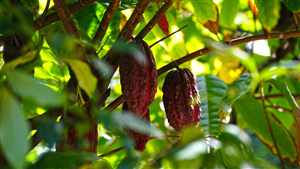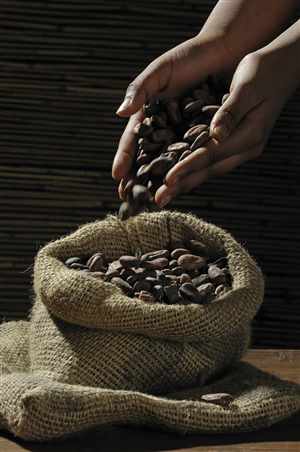Cocoa (Theobroma cacao)
Main Facts about Cocoa

Cocoa is a small evergreen tree, 20 to 50 feet tall (smaller when cultivated), that bears long, thin leaves and small yellow flowers formed directly on the plant’s stems. The flowers develop into small, football-shape seedpods that contain the Cocoa beans. Parts used – seeds (beans).
Native to tropical rainforests of Central and South America Cocoa is also cultivated in Africa, Indonesia, Hawaii, and elsewhere.
In Central and South America, Cocoa beans formed the basis of the traditional Aztec drink “chocolatl” (also known as “xocoatl”), meaning “bitter water”, which was enjoyed by ancient Inca, Maya, and Aztec peoples. Since the drink was made of pounded Cocoa beans and spices, without sweeteners, it had an extremely bitter taste. Most people could afford the expensive drink only on special occasions, but members of royalty consumed this beverage frequently as a sign of their elevated position. The ancient Aztec king Montezuma believed the plant had powerful aphrodisiac effects. According to the Spanish conquistador Hernando Cortes, Montezuma consumed large quantities of chocolatl daily – drinking it from golden goblets – and freely shared it with Cortes. Cortes sent Cocoa beans to the king of Spain, where it became popular in Europe in the mid-17th century.
For centuries, Central Americans have used Cocoa to treat fever, coughs, and problems associated with pregnancy and childbirth. They have also applied Cocoa butter to soothe burs, chapped lips, balding heads, and the sore nipples of nursing mothers.
Today, the tree’s seeds are dried and roasted to produce Cocoa powder, Cocoa butter, chocolate, and a skin-softening ingredient used in cosmetics.
Using Cocoa

The theobromine in Cocoa relaxes the smooth muscle lining the digestive tract. Try some to soothe your stomach after eating.
Theobromine and caffeine help open the bronchial passages. Cocoa may provide some relief from the chest congestion of colds and flu.
By virtue of a small amount of caffeine Cocoa and chocolate contain, they may relieve drowsiness and provide mild stimulation without the jitteriness, insomnia, and irritability that coffee can cause.
While chocolate does contain saturated fat, it does not raise cholesterol levels when enjoyed in moderation.
Cocoa is a remedy for: Cold and flu, Anxiety
Cooking with Cocoa
Cocoa is best known as the base ingredient of chocolate. There are several types of chocolate: dark chocolate, which has the lowest sugar content; milk chocolate, which contains dried or condensed milk; and white chocolate, which is made from Cocoa butter with added milk and sugar, but no Cocoa solids. Chocolate can be used in candy, baked goods, and beverages, as well as in savory meat dishes and sauces, including Mexican mole sauce. It is also used to flavor liqueurs.How to grow Cocoa
Cocoa trees grow in fertile, moist, well-drained soil in shade. The trees require a minimum temperature of 61F and high humidity, and they must be sheltered from the wind. In temperate North America, the Cacao tree can be grown in a large pot in a warm greenhouse, exposed to bright but indirect light. After 2 or 3 years, flowers may form, and a few of these may in turn form seedpods. The pods contain edible white pulp and 10-60 seeds, which can be used to make Cocoa. Commercial growers dry the seeds in the sun for 2 to 8 days, then roast and process them for use as Cocoa. Plants as propagated by seed.| Cloves |
Coffee
|